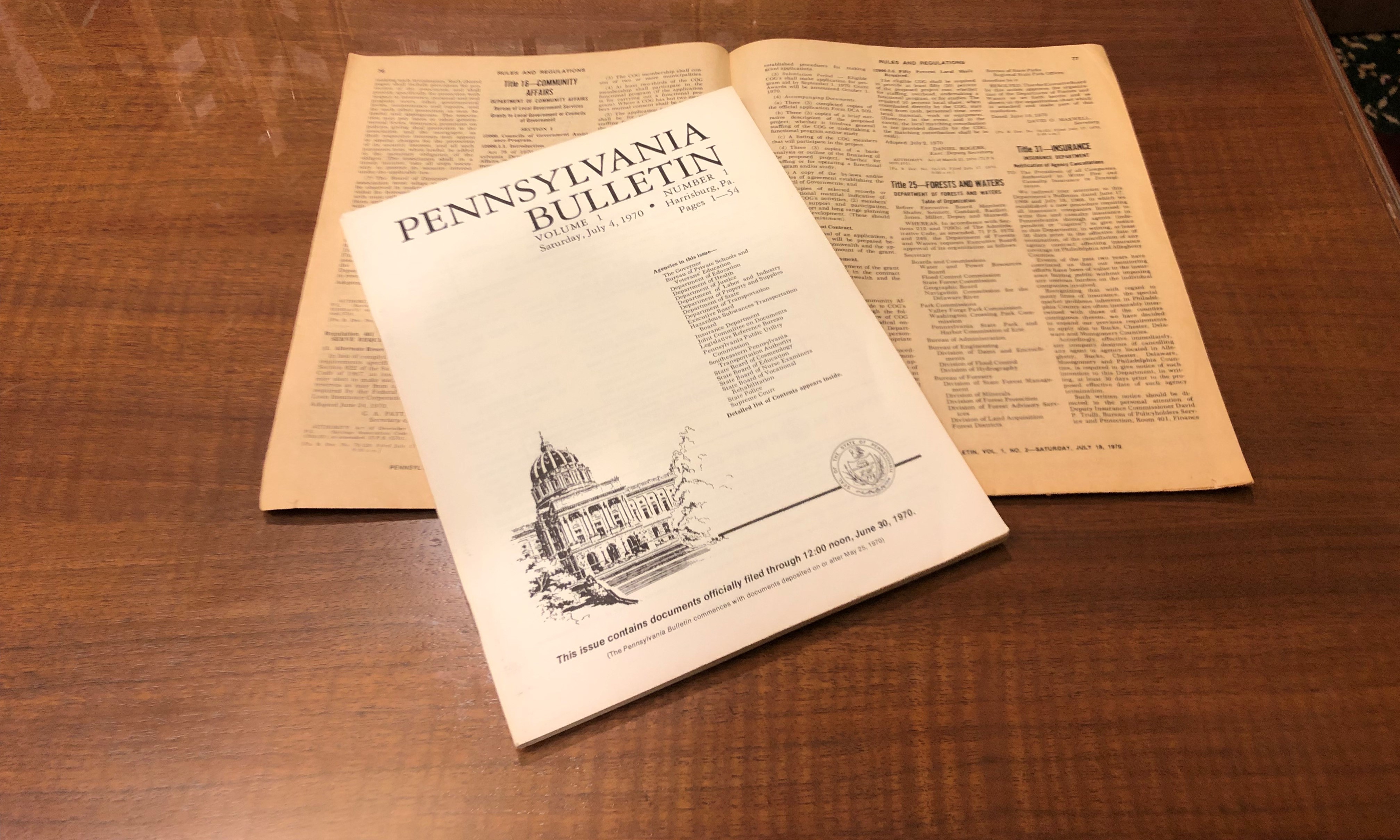About the Legislative Reference Bureau
Who We Are

In a message to the legislature on January 5, 1909, Governor Edwin S. Stuart remarked that it is unreasonable to expect that members of the General Assembly should be able to prepare bills upon every subject that may come before the Senate or House of Representatives. To provide the legislature with every reasonable assistance, Governor Stuart recommended the establishment of a legislative reference department.
The Legislative Reference Bureau was established by the act of April 27, 1909 (P.L.208, No.143). It was reorganized as a legislative agency by the act of May 7, 1923 (P.L.158, No.119).
The Bureau was created for the use by the members of the General Assembly, the Governor, the heads of State agencies and, in certain cases, such citizens of the Commonwealth as desire to consult it. Speaking at the 15th Annual Meeting of the Pennsylvania Bar Association in June 1909, Pennsylvania Attorney General M. Hampton Todd highlighted the establishment of the Bureau as marking an epoch in Pennsylvania’s social development.
With a long and proud tradition of providing exceptional service and expertise, the Bureau prepares thousands of bills, amendments, resolutions and citations for introduction by the members of the Senate and House of Representatives during each two-year legislative session. For decades, the Bureau has been staffed by highly trained and skilled practitioners in the field of legislative drafting.
Interested in hearing more about our history? Click below to read our history and how we began.
For 110 years, the Bureau has drafted legislation for members of the General Assembly. In 1910, the Bureau’s first assistant director, James McKirdy, summarized many of the bureau’s duties, writing:
“…if any member so requests, we shall draft any bill for him that he may desire to introduce…one of our chief rules is never to urge nor to oppose any legislation in any manner, directly or indirectly. And to this end we shall draw a bill for a member solely in accordance with his instructions, taking extreme care however to see that it does not infringe any of the prohibitions of our state constitution. Therein we imagine we shall be of greatest service to our law makers.”
Pictured is the progression of an idea into a blueback, a document that is ready for introduction in the House of Representatives or Senate. The drafting process begins with a request, sent from a member or legislative staff, to a drafting attorney in the Bureau. The drafting attorney follows up with the member, if needed, to ensure that the member’s objectives are accomplished.
Once the drafting process is complete, the blueback is sent to the member for introduction. After a bill is introduced, the Bureau again becomes involved in the legislative process if a member or committee chooses to amend a bill. Amendments are drafted by the Bureau for members’ introduction and engrossed into a bill by the Bureau after an amendment is adopted.
Another function of the Bureau is furnishing advisory legal opinions to the members of the General Assembly and heads of State agencies. The Bureau does not issue rulings or binding legal opinions.
The Citations unit creates citations to recognize constituents’ milestones. Citations are sponsored by members of the Senate and House of Representatives and include congratulatory citations to recognize and celebrate individual and organizational achievements and condolence citations to honor the lives of military personnel, first responders and other noteworthy individuals. On average, more than 15,000 citations are prepared annually.

The Pennsylvania Code is the official publication of State agency regulations and court rules and the Pennsylvania Bulletin is a weekly publication of that material. The legislation authorizing these publications was the result of decades of effort by many individuals, organizations and sessions of the General Assembly.
Beginning in the 1930s, the Joint State Government Commission undertook a comprehensive study of the then-existing practice and procedure of various Commonwealth administrative tribunals. The study eventually led to the enactment of the Pennsylvania Register Act that, in 1945, established an official medium called the Pennsylvania Register for the publication of rules and regulations. Another enactment, the Administrative Agency Law, provided that a regulation is not valid unless published in the Pennsylvania Register.
The Bureau proceeded to codify all regulations of State agencies and, in 1946 and 1947, published a volume consisting of more than 1,100 pages. The first volume was only half of the project, with a second volume planned for the regulations of the Department of Labor and Industry and the Pennsylvania Public Utility Commission. The second volume was never completed because the act authorizing it was repealed.
In 1968, the Commonwealth Documents Law was enacted to again give the Bureau the duty to publish agency regulations and place them into a system that ensured the published text was authoritative and up to date. It took more than ten years for this effort to be completed. Gary Hoffman was the attorney in charge of the vast amount of work. He was Director of the Pennsylvania Code and Bulletin office from 1969 to 2002.
Currently, the compilation, editing and supplementation of the Pennsylvania Code and Pennsylvania Bulletin is performed by the Bureau under the policy supervision and direction of the Joint Committee on Documents. The printing, distribution and marketing of the Pennsylvania Code and Pennsylvania Bulletin occurs through Fry Communications, a vendor under contract with the Department of General Services.

Since the legislative session of 1969, the Bureau has had the responsibility of editing and overseeing the publication of the slip laws and the Laws of Pennsylvania (Pamphlet Laws). In 1974, the Bureau was also given statutory authority to edit and issue an official publication of the Pennsylvania Consolidated Statutes, composed of 79 titles, arranged by subject matter.
The Editing and Publishing unit prepares these laws for print and electronic publication. In connection with this key role, the Editing and Publishing unit reviews legislative documents in draft form and as newly enacted laws; indexes the Laws of Pennsylvania and Pennsylvania Consolidated Statutes; prepares summaries of newly enacted legislation for publication in the Pennsylvania Bulletin; and coordinates the distribution of the slip laws, Laws of Pennsylvania and Pennsylvania Consolidated Statutes. The Editing and Publishing unit also has the responsibility of researching and updating compilations of Pennsylvania laws relating to firearms, veterans and emergency services for distribution by the members of the General Assembly.

The Legislative History unit performs the critical tasks of compiling, indexing and updating the legislative history for House bills and resolutions and maintaining files on the status of Senate and House of Representatives legislative documents under consideration or passed by the General Assembly. The Legislative History unit facilitates the referral and printing of legislation originating in the House of Representatives.
A reporter from the Legislative History unit is assigned to each chamber and reports legislative action when taken by that house. As legislative action is taken, the Legislative History unit updates bills of the House of Representatives electronically and informs the Senate of House action taken on Senate bills. The Legislative History unit responds to inquiries from members of the General Assembly, other agencies and the general public on the status of legislation.
When the Governor signs, vetoes or fails to act on a bill passed by the General Assembly in the time prescribed by law, the Department of State transmits this information to the Bureau, and the Legislative History unit updates the history of the bills of the House of Representatives accordingly.
The Legislative Reference Bureau, under section 504(a) of the Right-to-Know Law, as enacted February 14, 2008 (P.L. 6, 14, No.3) (65 P.S. § 76.504(a)) Purdon's Pennsylvania Legislative Service, No. 1 (2008), proposes to add 101 Pa. Code Chapter 31 (relating to Right-to-Know Law) as set forth in Annex A.
The Legislative Reference Bureau, an agency of the Pennsylvania General Assembly, has undertaken a long-term preservation and public access project to digitize the laws enacted for the Province and Commonwealth of Pennsylvania and published on a periodic basis from 1682 to the most recently completed session of the Pennsylvania General Assembly, referred to for purposes of the project as "session laws."
The project plan provides for incremental availability of the session laws. The first collection, the Statutes at Large, has been completed. The 18 volumes in this collection contain public and private laws of the Province and Commonwealth of Pennsylvania through the early nineteenth century. The second collection, the Smith's Laws, and the third collection, the Pamphlet Laws, are in varying stages of completion.
Session laws are displayed as originally enacted and do not reflect subsequent amendments, repeals or other modification. Text is in Portable Document Format, and a browser plug-in is required to view the documents. Adobe Acrobat Reader is a free plug-in which may be downloaded from Adobe Systems Incorporated.
The Legislative Reference Bureau is located in room 641 on the fifth floor of the Main Capitol Building in Harrisburg. The Bureau is open from 8:45 a.m. until 4:45 p.m. Monday through Friday, except for official State and Federal holidays and other days the Bureau is closed by direction of the Bureau Director.
641 Main Capitol Building, Harrisburg, PA 17120-0033
Phone: (717)787-4223
Fax: (717)783-2396
